- Provider tags: Tags that are directly associated with and managed within your cloud service providers, such as AWS, Azure, or GCP. These tags are typically applied to resources in your cloud environment to organize and categorize costs. Vantage retrieves and displays these tags in reports, which allows you to analyze costs based on existing tagging strategies.
- Virtual tags: This feature can help to increase tagging coverage across your cloud infrastructure. Create cost allocation tag keys with a set of corresponding values and filters directly in the Vantage without needing to involve your engineering team in making infrastructure changes. All provider integrations in Vantage are supported, including providers that don’t natively support tags. Virtual tags are available for filtering and aggregating on all Cost Reports and cost allocation segments. They can also be used in filter criteria on saved filters.
Tag Management: Provider and Virtual Tags
On the Tags page, you can view all tags, including both provider and virtual tags. From the top navigation, click Settings. On the left navigation, under General Settings, click Tags. Two tabs are displayed: All Tags and Virtual Tags.- On the All Tags tab, you can view both your provider (denoted by a grey tag icon) and virtual tags (denoted by a purple tag icon). Tags are listed along with any associated providers. You can also hide or unhide a tag and view a corresponding Cost Report filtered to that tag (see sections below).
- If you select a provider tag in this view, a new screen to create a virtual tag with the same name is displayed. You may want to do this in cases where you want Vantage to combine filter criteria from different providers but use the same tag name.
- If you select a virtual tag in this view, the virtual tag page is displayed, where you can edit any existing tag criteria.
- On the Virtual Tags tab, you can view a list of all created virtual tags. A link to the virtual tag is provided. The Tag Values column indicates how many values are currently associated with the virtual tag. Any associated providers are listed, as well as when the tag was created and who created the tag in Vantage.
View Tags on a Cost Report
From the Tags page, you can view a Cost Report that is filtered and grouped based on a selected tag. You can do this for both provider and virtual tags. This can help you to view any current or past costs associated with the tag. In the below visual example:- The user searches for the
environmentvirtual tag and selects to view a Cost Report for that tag. - The Cost Report is displayed. The report is also filtered by the tag’s associated providers by the tag and grouped by that tag’s values.
Hide Tags
From the Tags page, you can hide tag keys that you don’t want to appear in report filters or grouping options. This is useful for removing redundant tags or preventing other users from seeing certain tags in reports. To hide a tag key, click the eyeball icon next to the tag on the All Tags tab. As soon as a tag key is hidden, the following changes occur in Vantage:- Hidden from report menus: The tag key is no longer displayed in the Filters or Group By menus on reports for other Vantage users; however, users with the Owner role can still manage tag visibility (i.e., unhide the tag) via the Tags screen.
- Existing reports remain functional: If a report was already filtered or grouped by the hidden tag, it will continue to work, but if you edit the report’s filters, the hidden tag will no longer be available in the filter’s selection list.
- Usable in virtual tags: Hidden tags can still be used when creating virtual tags and will appear in virtual tag filters. If a hidden tag is included in a virtual tag’s filter criteria, a message is displayed next to it, indicating that it is hidden and only usable for virtual tag creation.
- Still accessible via API: Hidden tags remain available through API requests.
Hide Tags Example: Standardizing Redundant Tag Keys
You are working to clean up your tagging and notice that teams have applied multiple variations of the same environment-related tag key across different AWS resources:envenvironmentEnvironment
- You navigate to the Tags page in Vantage to search for and identify the different versions of the environment tag. You then hide each iteration of this tag so that you can create a new standardized version of the tag with Vantage virtual tags.

- All three hidden tags no longer appear in the Filters and Group By menus for other users.

- Existing reports that were already filtered or grouped by these tags remain functional; however, if a user edits the report’s filters, they will no longer see those hidden tag variations.
- The hidden tags are still available via API requests, so any external automation using them still continues to work.
- You create a new virtual tag named
environmentthat consolidates all three variations from the AWS provider tag. - For each tag value (e.g.,
productionordevelopment), you create a filter that combines theproductionvalues from the previous tags. You can then use this new virtual tag within reports.

environment virtual tag in their report filters, reducing confusion and keeping reports standardized. This approach helps enforce tagging consistency without you having to further educate your users on which versions of a tag key to use in reports.
Virtual Tags
Virtual Tags vs. Saved Filters vs. Cost Allocation Segments
Virtual tags can be considered foundational to the rest of the data within Vantage. They should remain fairly static, and changes should be considered delicate. These changes will flow across all data and apply to all workspaces. The most common tag keys will be items like team, cost center, and environment. Segments can then be used to create different hierarchical views for tagged data. This feature is useful for breaking down the data by different perspectives, such as by cost center or by OPEX/CapEX. Saved filters can then be used in a more ad-hoc fashion to add lenses on top of base data. For instance, you could create a saved filter just for North America that standardizes a set of regions across providers and can be used by teams on their reports or dashboards without having to know the set of filters needed to create the list of regions. When new regions come online, it’s easy to modify the saved filter to include this region.Custom Value Tags
With custom value tags, you can create new cross-provider cost allocation tags to help better your tagging strategy. For example, you may have a series of resource tags, by product, across each of your providers. You can create custom tags in Vantage to combine those costs into one unique product tag for all resources in that product group. See the example section below for details.Cost Allocation Tags
Vantage supports three types of cost allocation for Virtual Tags, allowing you to distribute costs across teams, applications, or internal financial models:- Cost-Based Allocation: Allocates costs proportionally based on another existing set of costs
- Business Metrics-Based Allocation: Allocates costs proportionally based on external business metrics
- Percent-Based Allocation (in preview): Allocates costs using fixed, manual percentages
Cost-Based Allocation Tags
With cost-based allocation tags, you can create a dynamically allocated cost structure. Select a set of input costs (e.g., all AWS costs), an existing cost tag to use for allocation (e.g., a teams cost tag), and an output cost (e.g, a static cost, like AWS Support) that you want to be allocated the same way as your input cost. See the example section below for details.Business Metrics-Based Allocation Tags
With business metrics-based allocation tags, you select an existing business metric (e.g., CPU use per product) and indicate your output cost (e.g., all GCP Compute costs) so that the allocation of the output cost mimics the percentage allocation of the existing business metric. See the example section below for details.Percent-Based Allocation Tags
- Predefined internal chargeback models with negotiated splits
- Manual cost-splitting requirements
- Costs with fixed allocation agreements (e.g., AWS Shield, Marketplace purchases)
Virtual Tags Limit
You can create up to 50 virtual tag configurations, with each tag supporting up to 100 configuration values. A warning is displayed when you approach the virtual tag limit to help you manage your virtual tag usage before reaching the limit.Create Virtual Tags
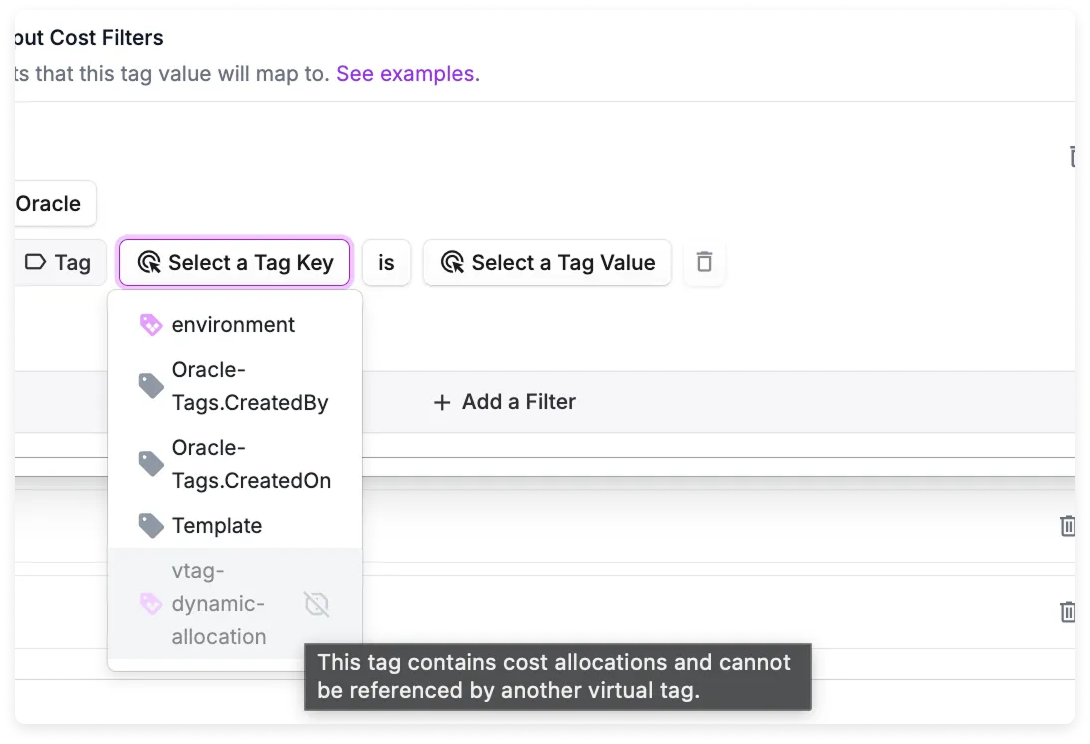
- Add Custom Value
- Add Business Metric Value
- Add Cost-Based Value
- Add Percent-Based Value
\_ - & + , . : / \ @. You cannot use saved filters to define a virtual tag value’s filters.
Nested Virtual Tags
With nested virtual tags, you can use virtual tags as part of the filter criteria for other virtual tag values. Nested virtual tags apply to Custom Value Virtual Tags and Percent-Based allocation tags. These tags let you align cloud provider data with internal taxonomies for effective grouping and querying. To reference an existing virtual tag in another virtual tag:- Select a provider.
- Select Tag, then select an existing virtual tag key. Look for the purple tag icon with the Vantage logo to identify existing virtual tags.
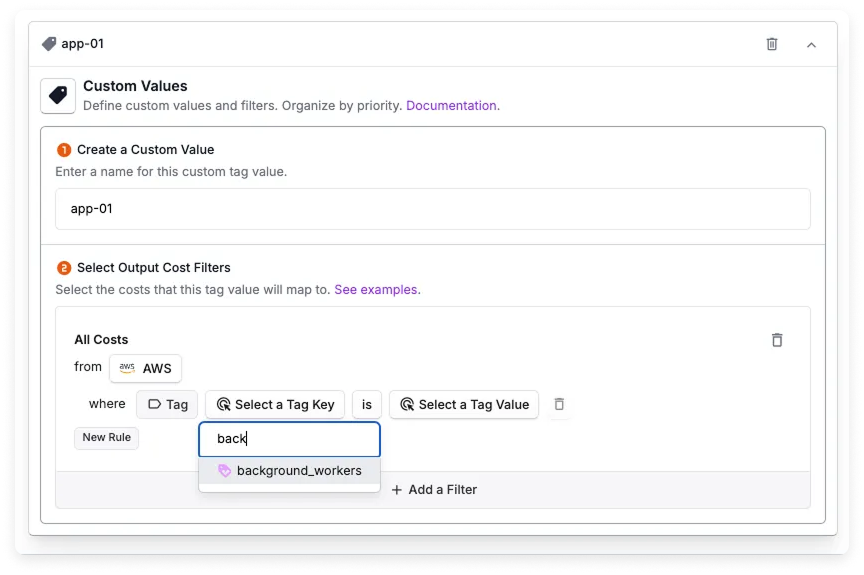
Nested Virtual Tag Considerations
- Do not create a nested virtual tag that references itself (i.e., a cyclical reference); this will result in an error.
- If you update the filters of a virtual tag that is referenced by another virtual tag, costs are reprocessed based on the updated hierarchy.
- If you delete or rename a virtual tag that is referenced by another virtual tag, you will see a warning. If you proceed, Vantage reprocesses costs with the new configuration.

- You can create up to 49 nested virtual tags, since an organization is limited to 50 distinct virtual tag keys. Because nested virtual tags are processed sequentially, increasing the number of nested values will slow down the tagging process.
Virtual Tag Order
Tag values are arranged in priority order on the Virtual Tags screen. You can move tag values up and down in the UI to reorder them, as demonstrated in the visual example below.
Filter and Group by Virtual Tags
You can filter by virtual tags in Cost Reports, cost allocation segments, and when creating saved filters. Virtual tags are visible along with your existing provider tags. Use the Tag (Label in GCP) filter and grouping option.
Delete a Virtual Tag
To delete a virtual tag, navigate to the Tags page. Select the Virtual Tags tab and open an existing virtual tag. Click the trashcan icon at the top of the tag page. Your data will be re-tagged, excluding the deleted virtual tag, going back to the deleted tag’s backfill bill period. Newly ingested data will no longer be tagged with the deleted tag.Virtual Tagging Examples
The following examples demonstrate how to use virtual tagging in a multi-provider organization.Custom Values Examples
Example 1 - Cross-Provider Tagging
You want to create a tag mapping for each of your teams that maps corresponding teams with certain services and provider accounts.Create a New Tag
Teams.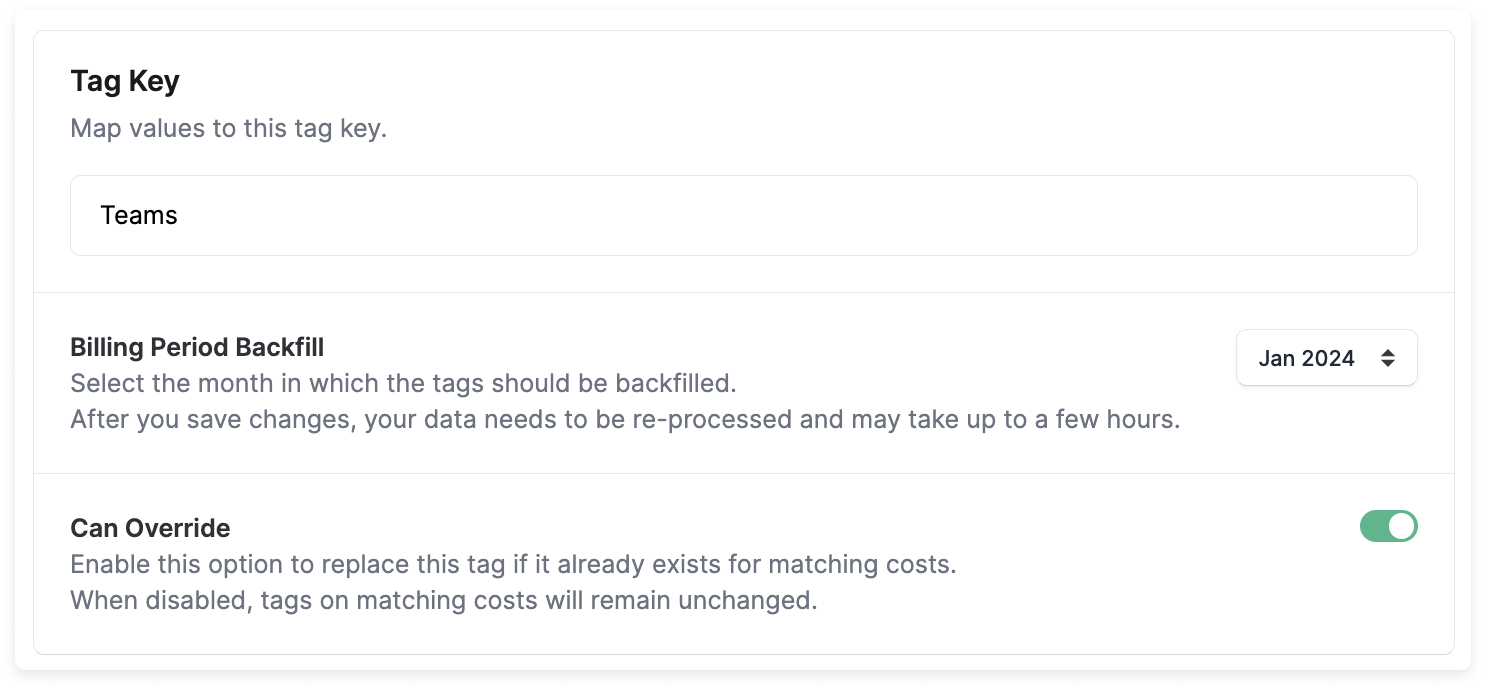
Add Tag Values and Filters
- The
datateam tag value corresponds with a filter for all costs for GCP BigQuery and Amazon Redshift. - The
mobileteam tag value corresponds with a filter for its related GCP projects and AWS accounts. - You continue this pattern and create similar values with corresponding filters for your other teams.

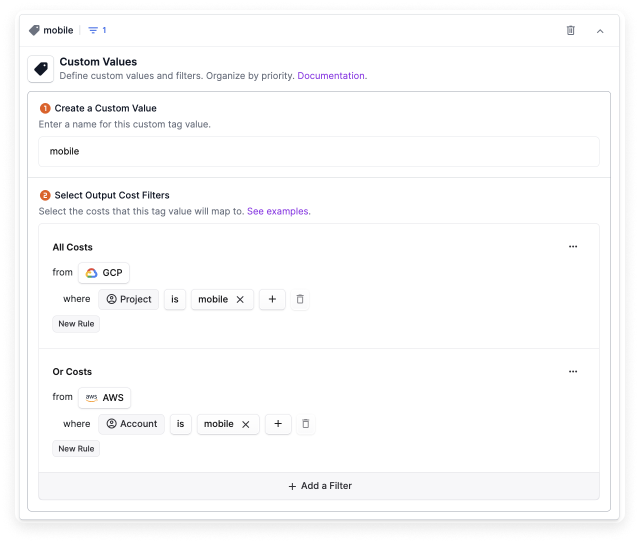
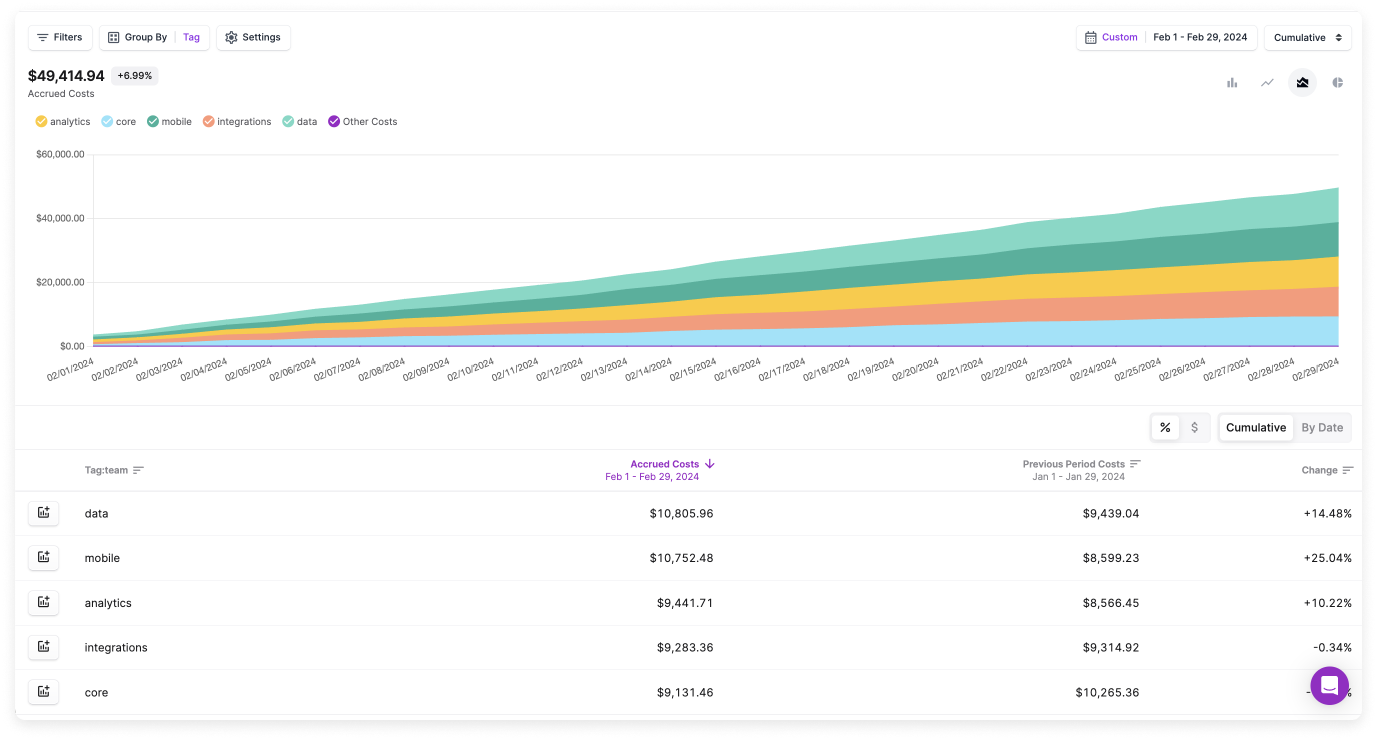
Example 2 - Consolidate Existing Tags
You have a tagging practice established at your organization, but teams often create tags with spelling variations, tags with typos, or they create duplicate tags. For example, thedata team has resources tagged with data, Data, and data-prod. This is an issue across many of your teams. You want to consolidate all these tags, across providers, into one data tag.
Create a New Tag
Teams to override existing tags.
Add Tag Values and Filters
data team tag are combined into one virtual tag.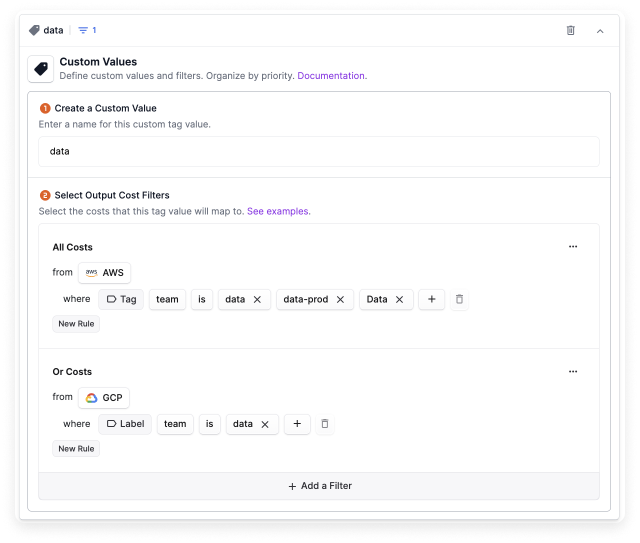
data team. This saves you the work of needing to always filter for all permutations of this tag. Now, you need to filter by only one tag.
Example 3 - Using Flexible Match to Consolidate Similar Tag Values
Your teams use inconsistent tagging conventions, resulting in multiple variations in casing and formatting. For example, Team A’s tag appears in several forms across usage data, such asteamA, team_a, team-a, and Team A. You can use the flexible match filter option to match for all of these variants, as well as future variants, in a single tag configuration.
Create a New Tag
Teams to override existing tags.
Add Tag Values and Filters
Teams flexible match to the string Team A.
teamA, team_a, team-a, and Team A .Cost-Based Allocation Example
In your organization, teams share resources, such as RDS databases or EC2 instances, and each team consumes different percentages of these resources each month. Your organization is also charged a static support fee each month for AWS. As shown in the diagram below, you want to allocate a portion of the support fee to each team based on their proportional use of AWS resources. So in the below example, since the Infra team is responsible for 50% of all AWS costs, they should also be responsible for 50% of the support fee. You can create a cost-based allocation virtual tag for allocating portions of the support fee to each respective team.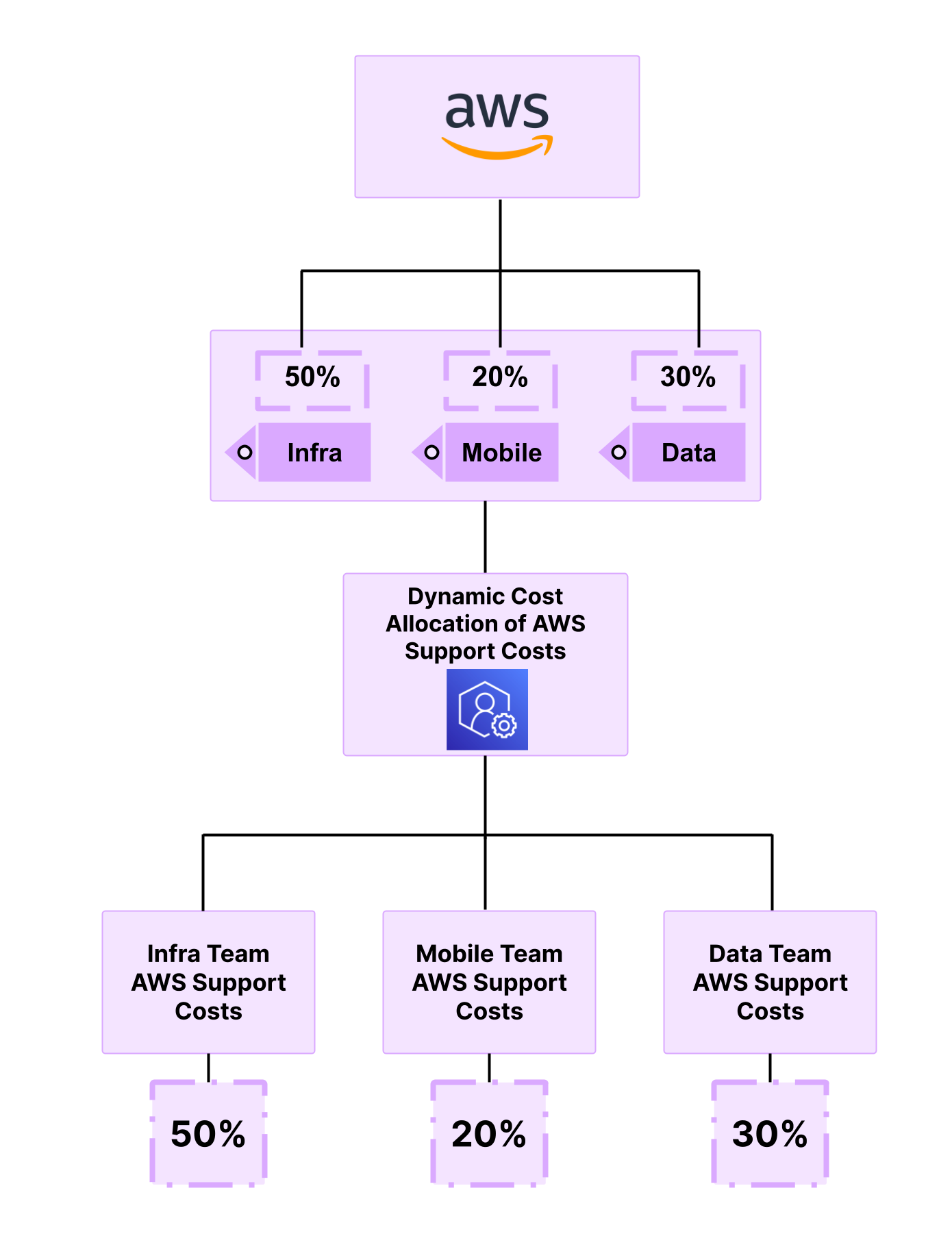
Prerequisites
Create a New Cost-Based Allocation Tag
- Navigate to Settings > Virtual Tags.
- Create a new virtual tag.
- Select the Cost-Based option for the tag value.
Select an Input Cost Filter
Select a Tag Key
Select an Output Cost Filter
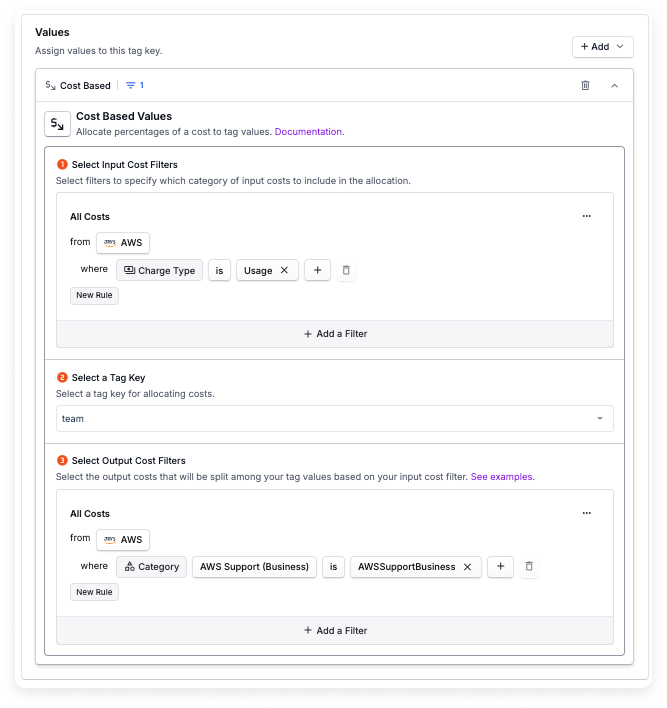
- Create a filter for AWS Support costs.
- Add grouping criteria to group by your new cost-based dynamic allocation tag.

Business Metrics-Based Allocation Example
You are working with your infrastructure team and want to ensure that the proportional cost of CPU time on a shared resource is allocated to the distinct cost centers that are consuming the CPU. In the below example, you want each team’s portion of CPU usage billed as a corresponding percentage of the overall Namespace CPU cost. So, if Team A uses 30% of the resource’s CPU, then they should be billed a proportional percentage of the total Namespace’s costs.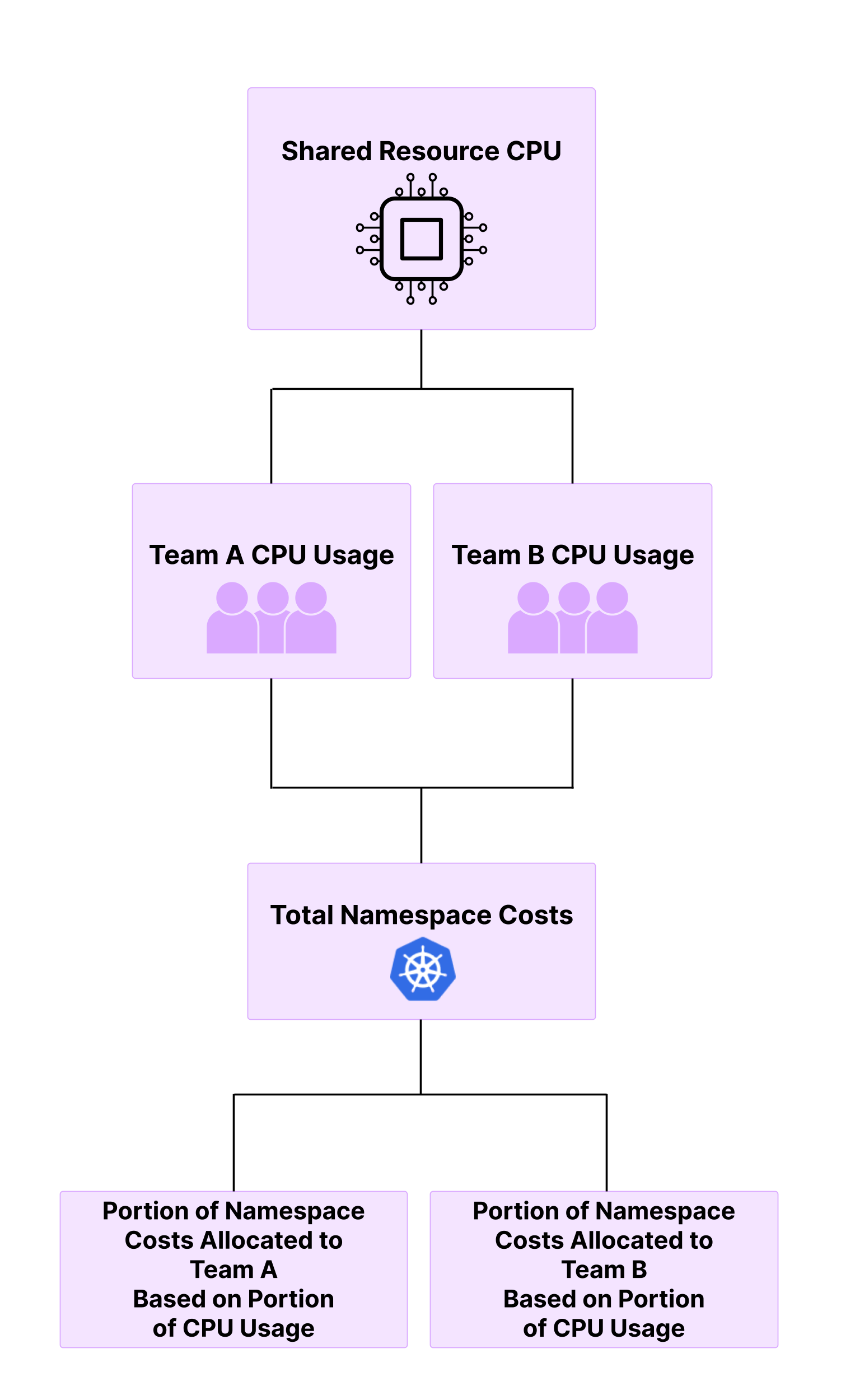
Prerequisites
Create a New Business Metrics-Based Allocation Tag
- Navigate to Settings > Virtual Tags.
- Create a new virtual tag.
- Select the Business Metric option for the tag value.
Select the Labeled Business Metric
Select an Output Cost Filter
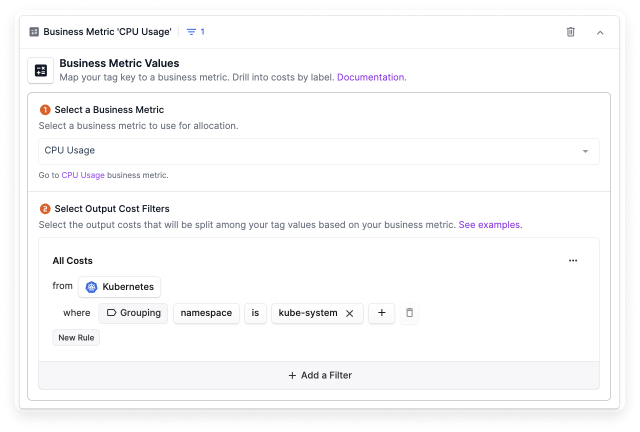
- Create a filter for the specific Namespace.
- Add grouping criteria to group by your new business metrics-based dynamic allocation tag.
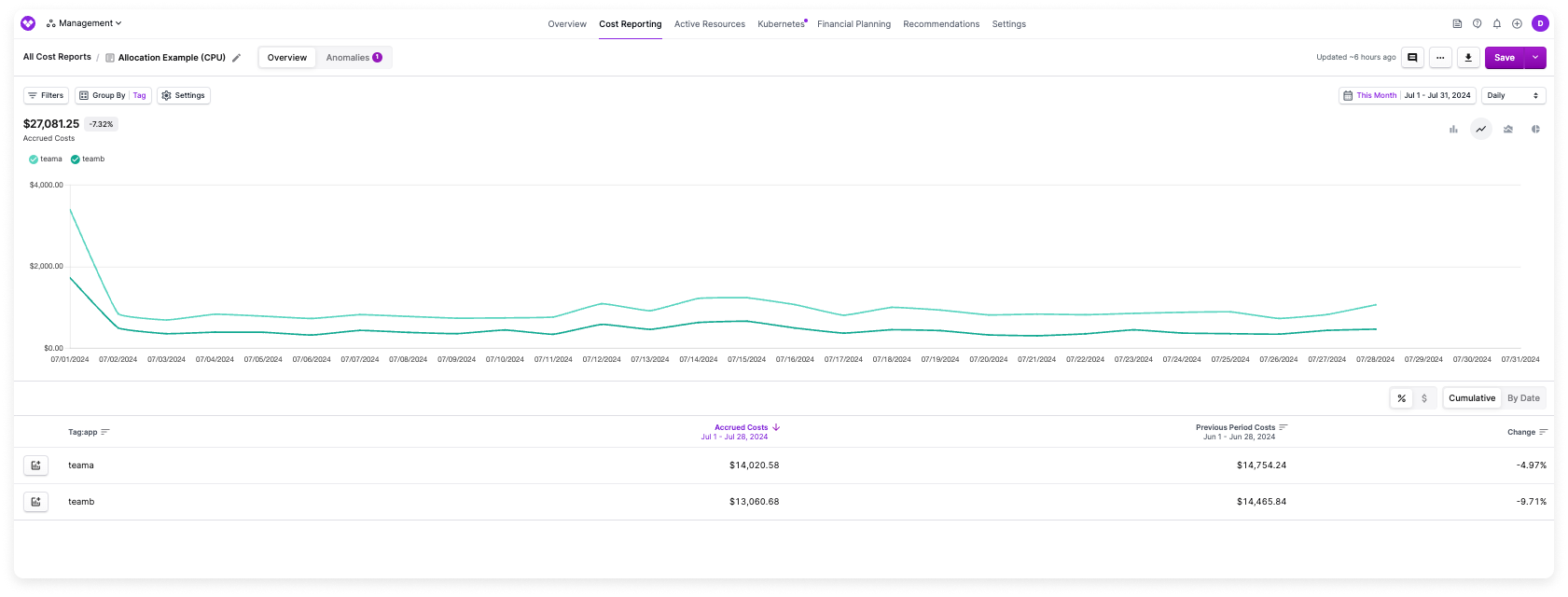
Percent-Based Allocation Example
Your organization has negotiated fixed cost splits for Marketplace purchases. For example, at the time of purchase, you pre-agreed that Marketplace costs should be split 60% to the Infrastructure team, 30% to the Mobile team, and 10% to the Data team. You want these allocations to be automatically applied in your chargeback models.Prerequisites
Create a New Percent-Based Allocation Tag
- Navigate to Settings > Virtual Tags.
- Create a new virtual tag (e.g.,
Marketplace Allocation). - In the Values section, click +Add and select Percent-Based.
Add First Tag Value - Infrastructure Team
- Specify the Output Costs Filter to match your Marketplace purchase costs (i.e., costs where Marketplace purchases Only).
- Enter the tag value name:
infra. Titles can contain only letters, numbers, and the following characters:_ - @ & + , . : / \. - Enter the percentage: 60 (between 0 and 100).

Add Second Tag Value - Mobile Team
- Click +Add a Tag Value to add another value.
- Enter the tag value name:
mobile. - Enter the percentage: 30.

Add Third Tag Value - Data Team
- Click +Add a Tag Value to add another value.
- Enter the tag value name:
data. - Enter the percentage: 10.

Review Allocations in Cost Reports
- Create a filter for Marketplace costs.
- Add grouping criteria to group by your new percent-based allocation tag.

Nested Virtual Tags Example
You want to maintain a hierarchy that reflects how your business units are associated with various applications, and track costs of all your applications per business unit over time. In addition, you also want to avoid having to manually update multiple virtual tags whenever an application changes ownership to another business unit, so you aim to set up a dynamic structure that’s automatically updated.Create an Application Virtual Tag with Values for Each App
- Each value represents a specific application (e.g., app1, app2, app3, app4).
- The filters for each value are AWS costs related to specific resources, like RDS or EC2 instances.
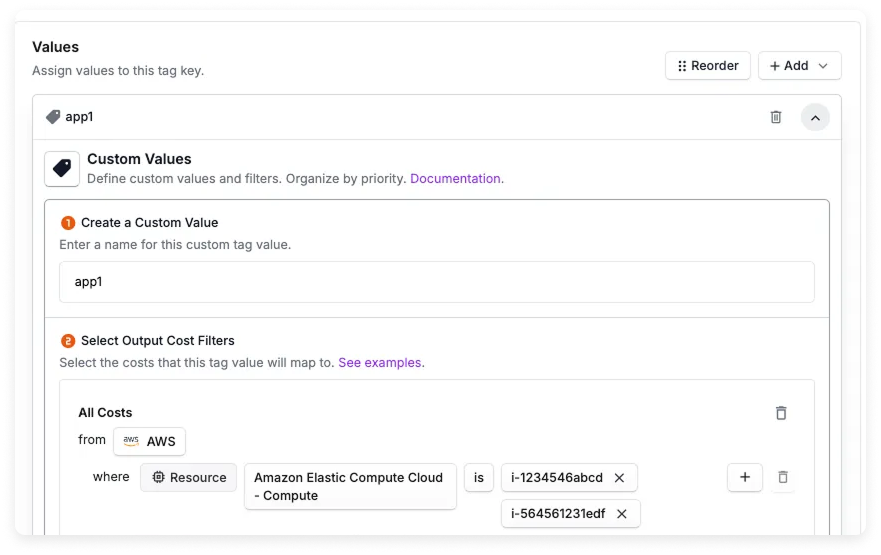
Create a Virtual Tag for Business Unit Costs
- Each value represents a specific business unit (e.g., Core Production, Core Development).
- Each filter uses the preexisting Applications virtual tag you just created to associate specific apps with the corresponding business unit. Notice that virtual tags are denoted by a purple Vantage tag icon to differentiate them from provider tags (gray icon).
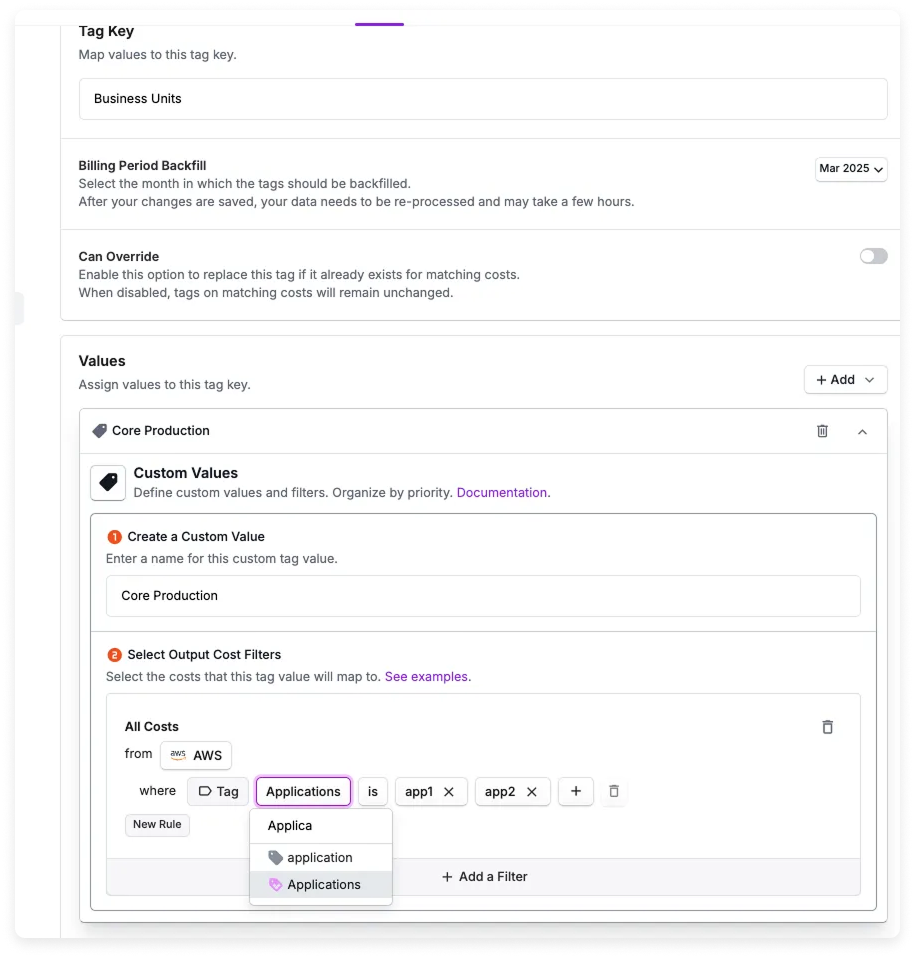
Review the Nested Virtual Tag in Reports

Tagging Untaggable Resources in AWS Example
While you can apply cost and metadata tags in AWS to many resources, there are many other resources that are untaggable in AWS. Therefore, it is hard, if not almost impossible, to achieve 100% allocation in AWS alone. One quick way to first get an inventory of all untagged resources in Vantage—regardless of if they are untaggable—is to create a Cost Report with the following filters:- Provider is AWS
- Where Not Tagged with Any Key
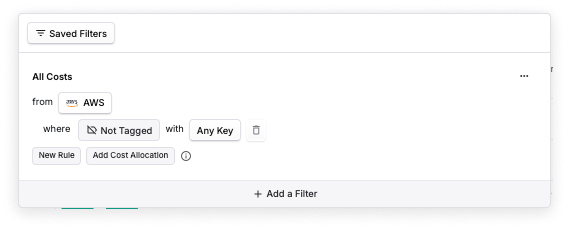

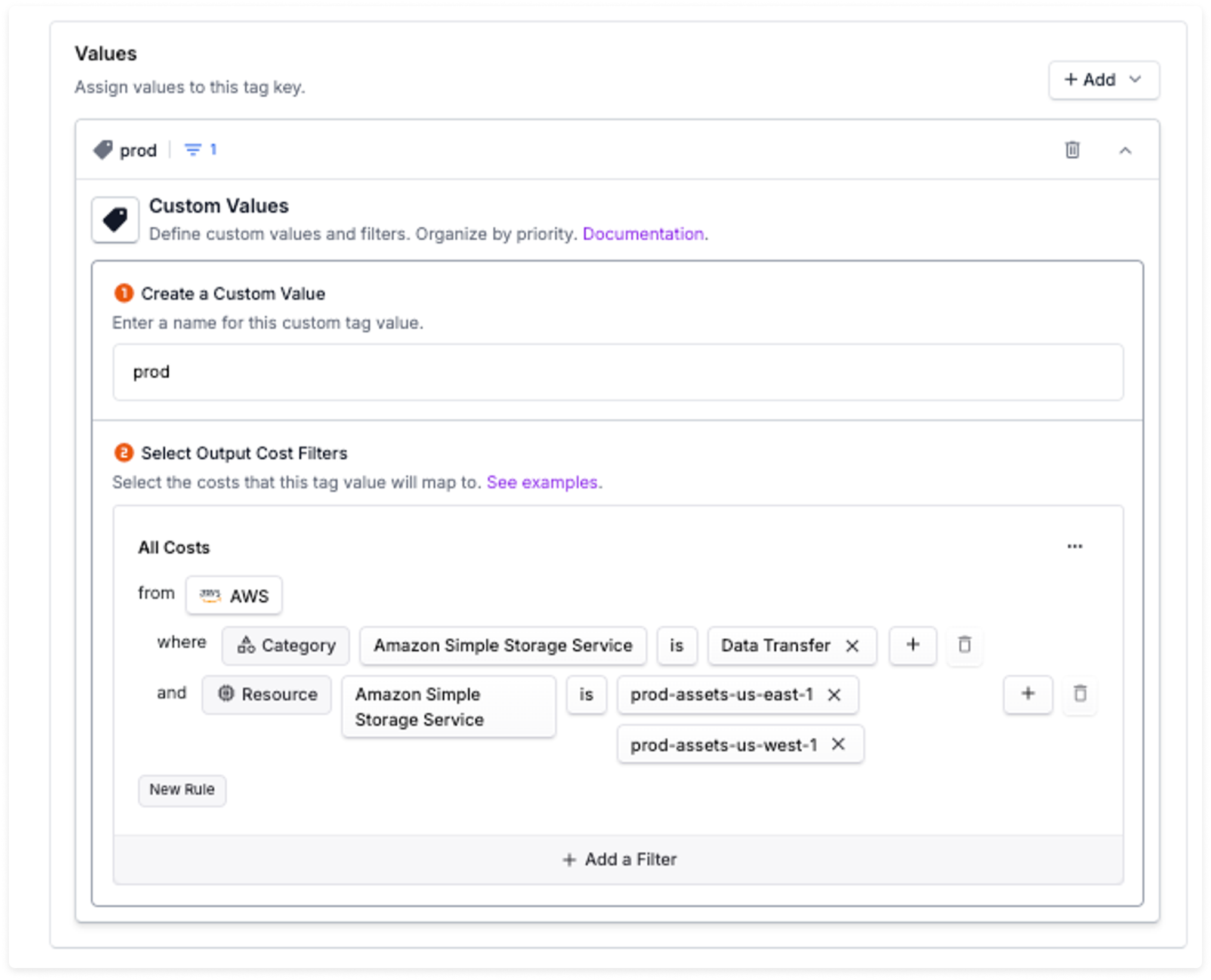
| AWS Resource | Description | Vantage Resource Filters |
|---|---|---|
| Elastic IPs | According to AWS, “You can tag an Elastic IP address that’s allocated for use in a VPC, however, cost allocation tags are not supported.” | Provider: AWS Subcategory: Amazon Virtual Private Cloud contains inuse |
| CloudWatch Metrics | CloudWatch Metrics involve performance data from AWS services, which are not taggable and are used for monitoring and alerting. | Provider: AWS Category: AmazonCloudWatch is Metric Further filter by resource ID |
| S3 Data Transfer | Data transferred in and out of S3 buckets, which is tracked but not taggable. | Provider: AWS Category: Amazon Simple Storage Service is Data Transfer Further filter by resource ID |
| QuickSight resources | Resources within Amazon QuickSight, such as dashboards and analyses, which do not support tagging. | Provider: AWS Service: Amazon Quicksight Optional detailed filters for Category (e.g., Business Analytics) or individual resource ID |
| CloudSearch resources | Amazon CloudSearch domains and their configurations, which are untaggable. | Provider: AWS Service: Amazon CloudSearch Optional detailed filters for Category (e.g., Data Transfer, Search Instance) or individual resource ID |
| EBS Snapshot Copy | Amazon EBS Snapshots that are copied between regions for Disaster Recovery or restore purposes | Provider: AWS Service: Amazon Elastic Block Storage (EBS) Category: Storage Snapshot Further filter for resource ID |